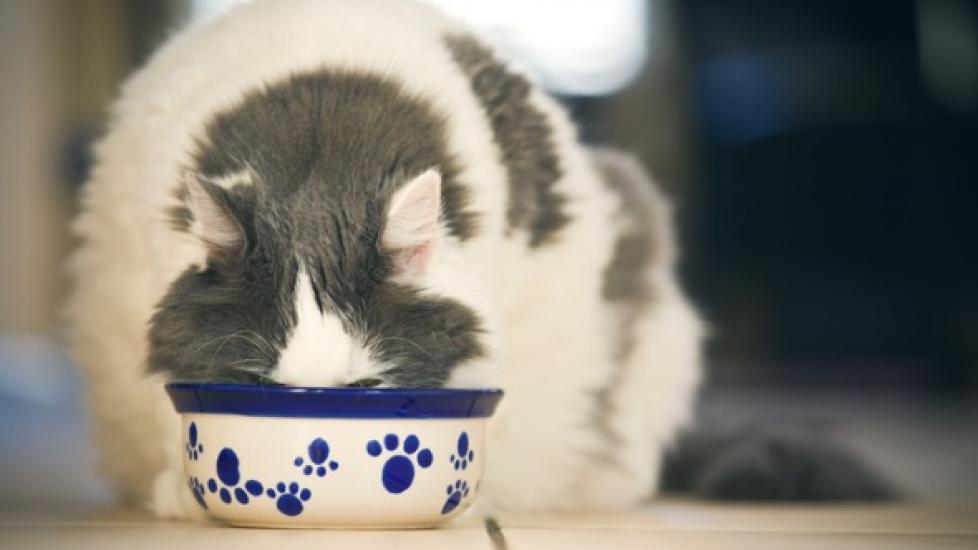How to Slow Down a Cat Who Is Eating Too Fast
Just about every cat owner has experienced excited meowing, the rubbing against your legs and the pleading stare—let’s face it, cats have a way of getting what they want! Unfortunately, sometimes when they get that worked up for a meal or treat, moments later, we’ll hear the familiar sound that sends us running for the paper towels. And then there’s the cleanup of the snack that now lies on the floor, looking completely undigested. How do we stop this cycle of cats eating too fast?
A Cat That’s Eating Too Fast Might Regurgitate the Meal
The good news is that there are several ways to slow down a cat that’s eating too fast. But first, what triggers the reflex that leads to regurgitation? Kitty eats too quickly—especially dry cat food—which then absorbs water, swells and sends the memo to the brain that the animal has overeaten.
The brain does the logical thing: Too much food in? Let’s get rid of some, and the regurgitation reflex is triggered. This is slightly different from the mechanism involved in cat vomiting, which can be a more concerning symptom. That being said—if your pet regurgitates frequently or shows any additional sign, such as weight loss, a trip to your veterinarian is warranted.
Vet Recommended Health Support
How to Slow Down Your Cat’s Eating
A good first step is to determine what is being regurgitated. If it is always the same brand of cat treats, for example, perhaps a switch to a different brand is in order. If it is always dry food, kitty may do better on canned, which also boasts a large number of health benefits and may be better in the long run. However, if no diet changes are in the future, it is possible to reduce or stop the bouts of regurgitation.
Try a Nonconventional “Bowl”
The first, and often simplest option, is to not use a typical cat food bowl, but instead spread the portion out on a 9- by 13-inch baking pan. This will space the food out markedly, leaving plenty of gaps between the kibbles or the chunks of canned food. Kitty must then take a bite—move along–take another bite—move along, markedly slowing the process from the typical GULP where half the bowl is eaten! Most of the time, this can slow the process down enough to resolve the problem.
Add an Obstacle
For cats that still eat too fast, however, or for those that do better with more traditional cat bowls, adding nonedible “obstacles” to the bowl can be helpful. This should be something too large for kitty to eat, and maneuverable enough that they can push it around while trying to get at the food below it.
Common items include ping pong and golf balls. If we are adding a second layer to the 9- by 13-inch baking pan strategy, larger balls such as tennis balls can be used. They will not work well for feeders that hold a large amount of food and replenish themselves automatically.
Use Automatic Cat Feeders
There are several types of automatic cat feeders that offer a feeding strategy that might be helpful. Some of these, like the PetSafe Eatwell 5-meal automatic pet feeder, can be set to open on a schedule and feed small meals frequently—which often helps prevent the regurgitation.
However, for many reasons—including weight control and appetite monitoring—the automatic feeders that don’t have portion control are generally not recommended or appropriate for feeding most cats.
Some automatic cat feeders have an ice pack below the bowl, to keep canned food fresh all day long—perfect not only for the “gulpers” in the house but also those kitties who just like being served fresh food multiple times per day (and who doesn’t?).
Try Cat Treat Toys and Slow Feeders
You can try slow cat feeder bowls that are shaped like mazes, making the cat work around the grooves and curves to get the food. You place the food in these slow feeders so that your kitty needs to solve a puzzle to get it, like with the Trixie activity strategy game tunnel feeder cat toy or the Northmate Catch interactive feeder.
Cat treat toys are also appropriate for curbing the gulping behavior. These need to be pushed or batted around into just the right position to release some of the food contained within–like with the Pet Zone IQ treat ball toy or the PetSafe Funkitty Egg-Cersizer cat toy.
These cat interactive toy options have the additional benefit of exercise and mental stimulation on top of providing nutrition—which more accurately simulates how it would be if the cat had to “work” to get its meals as it would in the wild.
Each of these techniques are most effective if kitty is being fed an appropriately portion-restricted amount of food and being fed once or twice per day. So, if you have stepped on yet another pile of regurgitation and swear it will be the last one, never fear. There are a number of options you can choose from, and certainly, one (or more!) will work for both you and your cat! I’m sure your kitty would rather have that favorite meal or snack in her tummy rather than on the floor, as well.
Image via iStock.com/sdominick
